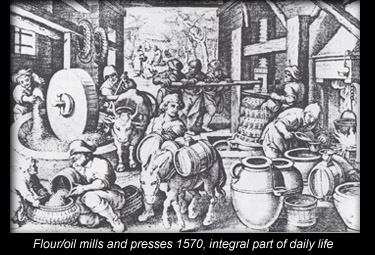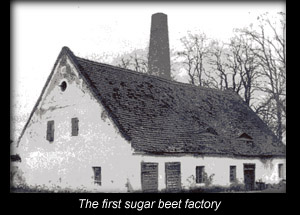
 Every culture has its roots embedded in history, and each culture has particular food preferences that are were dictated by climate. These rules have been laid down by nature. The climate determines what foods can/could be grown in a particular region, and thereby is/was the deciding factor for the type of food eaten by the local inhabitants. This naturally shaped and formed certain taste preferences 'taste buds' in a population.
Every culture has its roots embedded in history, and each culture has particular food preferences that are were dictated by climate. These rules have been laid down by nature. The climate determines what foods can/could be grown in a particular region, and thereby is/was the deciding factor for the type of food eaten by the local inhabitants. This naturally shaped and formed certain taste preferences 'taste buds' in a population.

Wheat is the most important grain for the production of bread, and has distinct historical roots that date back to the time when civilized man emerged. Rye is a much more recent grain that is used in our days to bake bread.

We have to remember that in earlier times we were not able to transport vast amount of foods (grains) like we are able to today. Once the railroads had their tracks laid, the movement and subsequent sale of huge quantities of grain was possible. Grain grown in Canada is sold worldwide: anywhere on the planet. Historically, however, the crops that were grown in a particular region were also consumed locally. The climate dictated what type of food (grain) could be grown in a particular region or plot of land.

Rye and wheat have different growing requirements. Wheat is split in two general categories: soft and hard. The soft is ideal for pastry, and the hard wheat for bread making. Soft wheat and rye share similar climatic conditions. They don't need the hot summers and rich soil that hard wheat requires. Rye and soft wheat can be grown in cool, damp climates. Hard wheat needs a lot of sun and rich soils to grow; the North American prairies are ideal, and are known for producing some of the best wheat for bread making in the world. It is also interesting that 5000 years ago these ideal climatic conditions were present in Egypt, the first civilization besides the Sumerians, who also had very fertile but limited land between the Euphrates and Tigris rivers.

 The origin of bread making (sourdough bread) was first discovered and developed in Egypt. They had the best climate and soil conditions (at the time) to grow hard wheat, and as their knowledge grew in agricultural practices, sourdough baking became more widespread. Baking with a sourdough culture was the first truly leavened bread. This bread was baked exclusively from wheat with a sourdough starter-culture. As depicted in the hieroglyphs, they seemed to have achieved fairly advanced baking technologies. This sourdough bread was the staple food for the Egyptian dynasty, until its demise.
The origin of bread making (sourdough bread) was first discovered and developed in Egypt. They had the best climate and soil conditions (at the time) to grow hard wheat, and as their knowledge grew in agricultural practices, sourdough baking became more widespread. Baking with a sourdough culture was the first truly leavened bread. This bread was baked exclusively from wheat with a sourdough starter-culture. As depicted in the hieroglyphs, they seemed to have achieved fairly advanced baking technologies. This sourdough bread was the staple food for the Egyptian dynasty, until its demise.

As the climatic conditions shifted and the northern part of the Mediterranean also began to be ideal for growing hard wheat, the Roman Empire emerged and rose to dominate Europe. The Romans built systematic bakeries, which included the milling/grinding of the wheat, and the baking of the bread. This fed their population and the Roman armies that eventually conquered most of Europe. The Roman army was fed mostly on wheat sourdough bread.

 Baking with Rye flour hadn't been discovered yet; this possibly allowed the Roman army to get a jump on things and conquer the barbarian countries to the north. The climate in the north was not favourable for hard wheat, but it was suitable for growing rye. It is quite possible that a clever Roman baker stationed in one of the conquered northern lands invented the technique of baking with rye flour. Countries like Russia, Sweden and Germany started to grow rye grains in large quantities, as the technique became more widespread. It is interesting to note that as the Roman Empire started to crumble just as these northern countries stared to really get the hang of baking with rye flour.
Baking with Rye flour hadn't been discovered yet; this possibly allowed the Roman army to get a jump on things and conquer the barbarian countries to the north. The climate in the north was not favourable for hard wheat, but it was suitable for growing rye. It is quite possible that a clever Roman baker stationed in one of the conquered northern lands invented the technique of baking with rye flour. Countries like Russia, Sweden and Germany started to grow rye grains in large quantities, as the technique became more widespread. It is interesting to note that as the Roman Empire started to crumble just as these northern countries stared to really get the hang of baking with rye flour.

Bread played a major role in emerging civilizations: it was a staple food that was economically produced to feed the population. It was a food that had substance, and promoted good health, and I believe that it has mainly to do with the fact that it is loaded with beneficial bacteria, which promote good intestinal health.

Rye breads are still predominantly baked in these northern countries. The taste for rye bread is so deeply imbedded in these cultures, that people are very reluctant to change.

 The North American prairies yielded ideal growing conditions for hard wheat, just like the Egyptians experienced thousands of years before. Being that the British and the French were the conquering nations in North America, and both favoured white bread, it is no wonder that because of these two circumstances, breads in North America are predominantly wheat and white. Other immigrant minorities have usually kept up their preferences by home baking. Since we have become more health conscious, this has improved, but we need to address the lack of a viable bacterial culture.
The North American prairies yielded ideal growing conditions for hard wheat, just like the Egyptians experienced thousands of years before. Being that the British and the French were the conquering nations in North America, and both favoured white bread, it is no wonder that because of these two circumstances, breads in North America are predominantly wheat and white. Other immigrant minorities have usually kept up their preferences by home baking. Since we have become more health conscious, this has improved, but we need to address the lack of a viable bacterial culture.

With the introduction of baker's yeast at the end of the 1800's, the sourdough culture was not needed to leaven the bread anymore, seeing as it was now done with commercial baker's yeast. This idea was heavily exploited by mega bakeries, and has shaped the landscape of the baking industry in North America.

The farmers of the new world (North America) have always been very proud of the hard wheat they grow. However, wheat allergies are nowhere else so wide spread. If the modern day baking practices don't start including a viable bacterial culture, then there may be a time in the new future when this bacterial culturally deprived bread won't be able to be tolerated by our digestive systems anymore.

 Since wheat is used in so many other products besides bread (cookies, noodles, breakfast cereals, etc) this compounds the above problem even more. All of these foods are basically dead foods. Even though these foods may still be nutritious, they are not probiotic; they burden our digestive system. We need to eat foods that replenish and keep our bacterial environment (the intestinal microflora) functioning properly. Dead foods have a draining affect on our intestinal microflora, and organs (pancreas, liver). This diminishes our vitality.
Since wheat is used in so many other products besides bread (cookies, noodles, breakfast cereals, etc) this compounds the above problem even more. All of these foods are basically dead foods. Even though these foods may still be nutritious, they are not probiotic; they burden our digestive system. We need to eat foods that replenish and keep our bacterial environment (the intestinal microflora) functioning properly. Dead foods have a draining affect on our intestinal microflora, and organs (pancreas, liver). This diminishes our vitality.

The climate in France is also suitable for growing hard wheat, and they love their white bread. The famous French bread is traditionally made with a sourdough culture. But modern baking practices have pretty well eliminated this, and a few specific acids are now added to the dough to give it the needed characteristics that is reminiscent of bread made with a real sourdough culture. The golf ball sized holes in a loaf of bread are a sign of wild yeast, but this does not necessarily mean that an active sourdough culture is at the heart of the bread. Many of today's artisan bakeries base their breads on this, but yeast as such, does not have any real value besides providing the necessary leavening needed to bake the bread successfully.

In former Communist countries like Russia, Poland, Bulgaria etc., that historically bake rye breads, many of the traditional ways of baking bread and pastries have been kept up. But this is changing fast as global mega-companies, who produce all the modern powders, mixes, etc., are flooding these countries to increase their markets. Even though the population is sometimes reluctant to adapt to the new products, the economic spirit will triumph. "The old is out and the new is in" as the saying goes.
